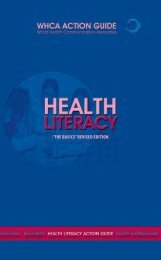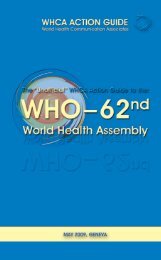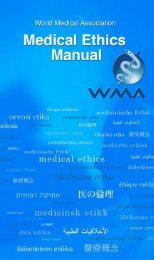Part 1 'the basics' - World Health Communication Associates
Part 1 'the basics' - World Health Communication Associates
Part 1 'the basics' - World Health Communication Associates
Create successful ePaper yourself
Turn your PDF publications into a flip-book with our unique Google optimized e-Paper software.
They also have to move from community settings to hospitals, and from public to<br />
private providers (IOM 2004, p.148). An adult’s ability or inability to make these<br />
decisions and navigate these systems is a reflection of systemic complexity as well as<br />
individual skill levels. Patients, clients and their family members are often unfamiliar<br />
with these systems. Their health literacy can be thought of as the currency needed<br />
to negotiate the system (Selden 2000); or a compass for what may be a difficult and<br />
unpredictable journey (Kickbusch and Maag 2008).<br />
health literacy enhancement interventions<br />
<strong>Health</strong> system related interventions to improve individual and population health<br />
literacy can be divided into four categories:<br />
1. Provision of simplified/more attractive written materials<br />
2. Technology-based communication techniques<br />
3. Navigator services<br />
4. Training of educators and providers<br />
4.1.1 Provision of simPlified/more attractive Written<br />
materials<br />
<strong>Health</strong> information materials and official documents—including informed consent<br />
forms, social services forms and public health and medical instructions—often use<br />
jargon and technical language that make them difficult to use (Rudd et al. 2000, cited<br />
in IOM 2003, p.168). Moreover, studies suggest that health information is often more<br />
difficult to comprehend than other types of information (Root and Stableford 1999).<br />
Most of the approaches in this category involve producing patient information<br />
materials that are written with simplified language, have improved format (for<br />
example, more white space and friendlier layout), or use pictograms or other graphics.<br />
4.1.2 technology-based communication techniques<br />
A systematic review of technology-based communication techniques shows that such<br />
decision aids improve knowledge, reduce decisional conflict and stimulate patients to<br />
be more active in decision-making without increasing anxiety (O’Connor et al. 1999).<br />
One widely-used type of technology-based communication technique is<br />
telephone-delivered interventions (TDIs), in which counselling and health reminders<br />
are delivered using the telephone or through text messaging. TDIs can vary by the<br />
Section 4: wHat can we do to StrenGtHen HealtH literacy? 21






